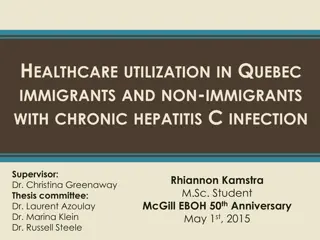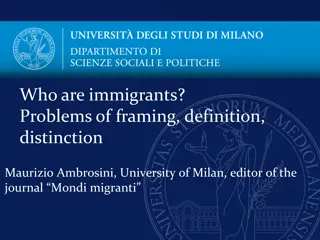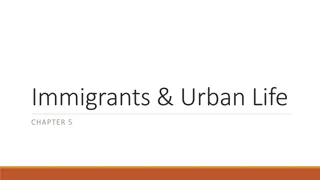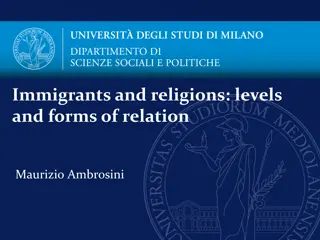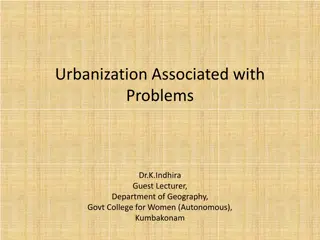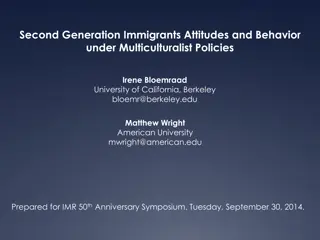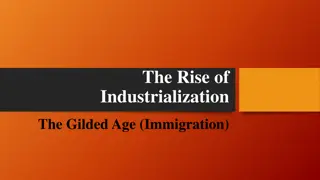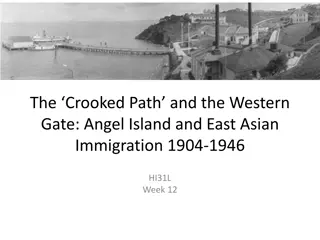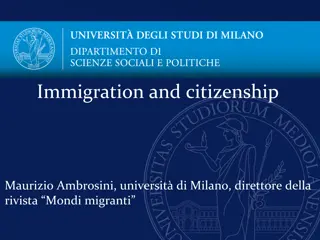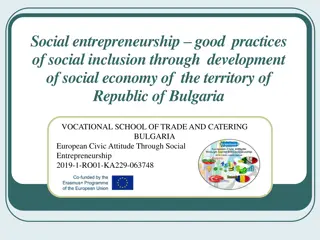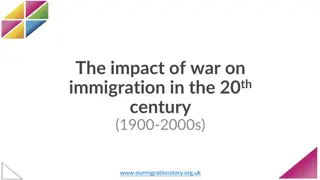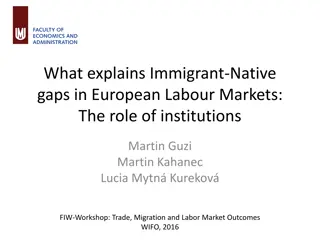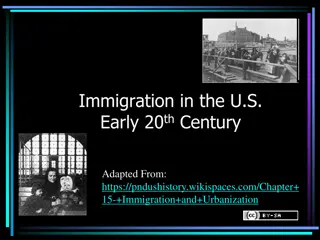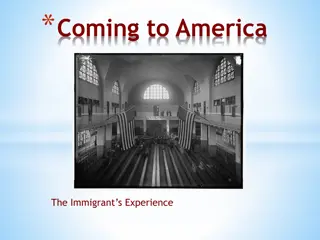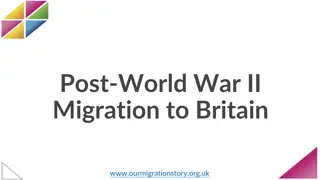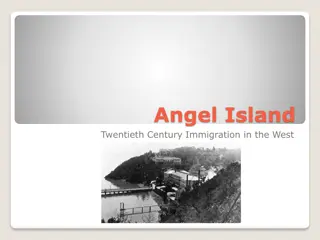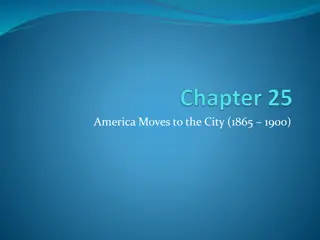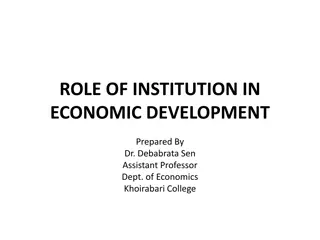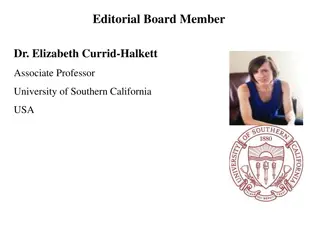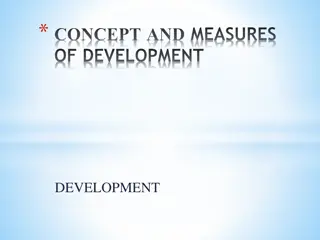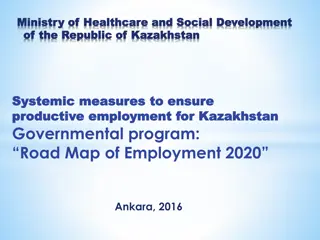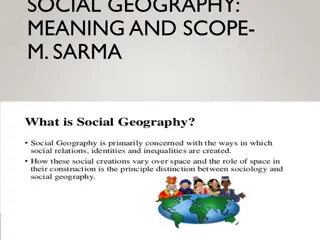The Impact of Immigrants on Scotland's Economic and Social Development
Immigrants played a significant role in Scotland's economy, filling crucial jobs and contributing to its growth. Over time, they integrated into society, though some groups maintained their own identity. The influx of Irish immigrants, escaping famine, was particularly influential, despite initial challenges such as language barriers and suspicions. Resentment grew towards poorer Irish immigrants settling in specific areas. Conflict among Irish immigrants was mainly along religious lines rather than with native Scots.
Download Presentation

Please find below an Image/Link to download the presentation.
The content on the website is provided AS IS for your information and personal use only. It may not be sold, licensed, or shared on other websites without obtaining consent from the author. Download presentation by click this link. If you encounter any issues during the download, it is possible that the publisher has removed the file from their server.
E N D
Presentation Transcript
The Experience of immigrants in Scotland
Growing economy => workers needed Scots moving from countryside to towns filled some jobs but immigrants important to Scottish economy By 1830, Scotland had a strong identity in terms of religion, language and culture. Immigrants with different religion, culture and language seen as a threat to Scottish way of life and viewed with suspicion Introduction
Over time, many immigrants integrate well, are accepted and play a vital role in Scotland s development However, some immigrant groups stay separate, within their own community, never losing their own identity Introduction
More and more cross to Scotland fleeing famine and poverty. Potato famine 1845-51 caused a huge increase in Irish migration More jobs and better paying jobs in Scotland Factories, railways, coal mines, jute mills and canals. Impact of Irish on Scotland is of huge importance Irish immigration
As well as having a different religion to most Scots, many Catholic Irish couldn t speak English. Viewed with suspicion However, important to remember that the first group of Irish Catholics integrated well with native Scots by changing surnames, inter-marrying and even converting to Protestantism Catholic Irish Experience
Any conflicts amongst Irish immigrants at this time (early 1840s) tended to be between Catholic Irish (Green) and Protestant Irish (Orange), not between Scots and Irish. Catholic Irish Experience
Growing resentment because the Irish who came to Scotland after 1845 tended to be poor, destitute, unskilled, uneducated and Catholic Irish tended to concentrate in certain areas of cities where cheaper but poorer housing existed, e.g. Maryhill in Glasgow or Lochee in Dundee Irish: Growing Resentment
Even the Government were concerned about the number of Irish coming into the country. They set up an inquiry and concluded: The Irish work for less money than the Scots; the work they do is the roughest and most repulsive work. Their way of life is similar if nit inferior to the poorest Scot. Irish: Growing Resentment
Historian T.C. Smout wrote: Poor or irregular wages meant it s more difficult to keep a respectable life style. It was easier to blow all the wages on drink or on a bet on a horse. Thus the Irish gained a reputation for fighting, drunkenness and general bad behaviour. You can see why middle class Scots thought Irish were, and remained poor, because they were morally bad. Irish: Growing Resentment
If you lived in Scotland for 3 years and were poor, you got Poor Relief. Some Scots thought Irish were only across in Scotland to get Poor Relief. (Similar to today s claims of immigrants being benefit scroungers ) Irish were strike breakers and willing to work for less money Protestant organisations emerged opposing Irish Catholic communities. They portrayed Irish as a threat to Scottish way of life. Irish: Growing Resentment
Catholic church expands its services to help with the increasing numbers of Irish. Catholic church a place of safety, security and identity for Irish Problem with this was the Catholic Irish remained within their Catholic community and thus didn t integrate well. Catholic Identity
Catholic schools developed. Funded by voluntary donations, which considering the poverty, was a remarkable achievement From 1918 they started to receive funding from the Government, i.e. tax payers which angered Protestants. It angered so many that a racist, sectarian political party was created. Catholic Identity
Catholic Irish supported Home Rule; Liberal Party Supported Home Rule => Catholic Irish generally voted Liberal up to Great War Brutality of British troops crushing Sinn Fein s Easter Rising in 1916 turned many Catholics to vote Sinn Fein. 1920 => 80 Sinn Fein clubs in Scotland After Irish Home Rule in 1922, Catholic Irish in Scotland tended to vote Labour. Why? The Irish and Politics
Economic downturns saw an increase in tensions between Scots and Irish. Irish seen as a drain on Scots 1920s, post war economic depression, saw wide spread violence between Catholic and Protestant communities Even the Church of Scotland joined in, producing a pamphlet in 1923 called, The Menace of the Irish Race to our Scottish Identity ! Sectarianism
It wasnt all negative. Working class Scots and Irish had shared experiences > effects of industrialisation + urbanisation; fighting together in the Great War Many Irish Catholics volunteered and fought for Britain, dying in large numbers, showing loyalty to the British State. Co-operation
Considerable co-operation between Irish Catholics and fellow Scots in the Trade Union movement, as well as the temperance movement The Miners Union had Catholic and Protestant members A march in July 1841 in July in Glasgow of the temperance movement saw 5,000 Catholic and Protestant teetotallers march together. Co-operation
About 1 in 4 Irish immigrant were Protestant. They had a lot in common with the average Scot. Initially they came to Scotland for seasonal work but as industrialisation increased, more of them moved permanently Many were skilled in the weaving trade and also worked as farm labourers but also in mines, shipyards and factories The Protestant Irish Experience
Protestant Irish made a very distinctive impact on Scotland through the Orange Order a Protestant organisation that was anti-Catholic By belonging to the Orange Order, Protestant Irish were maintaining a distinct identity, i.e. they were not Catholic Irish. The rivalries and disagreements between the Protestant and Catholic Irish transported itself over to Scotland Issues of Identity
Many shipyards and iron industries hired only Protestant Irish, which helped keep the Orange Order in Scotland strong This led to a misunderstanding that Protestant Irish were more skilled than Catholic Irish. This was not always the case. It was more a case of discrimination in the hiring of Catholic Irish. This is why some areas of Scotland had a predominance of Protestant Irish due to the unfair hiring practices. Issues of Identity
Protestant Irish opposed Home Rule because they saw that as a Catholic Irish demand The Conservative Party in Britain were/are very much a unionist party, so the Protestant Irish voted for the Conservatives, even the poorest Protestant Irish despite the Conservative Party s reputation for being the party of the rich and privileged Protestant Irish and politics
Ireland gained Home Rule in 1922. Northern Ireland remained united to the UK and thus was mostly Protestant. Home Rule saw the Protestant/Catholic divisions and disagreements subside a bit but not go away Protestant Irish and politics
the absorption of the Irish into the social fabric of Scottish life must be considered one of the achievements of Scottish history Historian T.C. Smout Sadly, in the 1920s and 30s and beyond, football fans and football clubs, like Celtic and Rangers, encouraged sectarianism and its accompanying violence as a crowd puller Irish: summary
Before 1860, only a small number of Jews lived in Glasgow (26 families). Many of these Jews were educated professionals Between 1880 and 1914, many more Jews arrived, mostly from Eastern Europe. These Jews were poor, fleeing religious persecution and economic hardship Many were escaping pogroms (organised massacres of a particular ethnic group) in Russia Jews
In 1903, Scotland had 6,000 Russian Jews. By 1919, there was 9,000 in Glasgow alone Most lived in the Gorbals area of Glasgow. A Jewish area emerged there. Yiddish was often heard in the Gorbals They developed into a community and built synagogues, reading rooms and a Benevolent Loan society Many involved in buying/selling door-to-door pedlars and hawkers Jews
Sweated trades are trades that paid low wages and forced workers to work long hours as they were paid per item made. By doing this they undercut skilled workers wages Sweated labour was mainly associated with Jewish immigrants. Tailoring mostly Many workers in these sweated trades were Scots and Irish but sweated trades still associated with Jews Unions not happy about Jewish sweated trades Jews and the sweated trades
Newspapers began publishing articles on how, Britain was an easy country to get into and had become a dumping ground for undesirables Jews who had been in Britain for a long time and had integrated well began to feel the new community of poor Jews threatened to alienate the local population, encouraging anti-Semitic behaviour This is similar to how relations with Irish and Scots worsened when more Irish came. Resentment of Jews
Poor Jews got relief from the Jewish community which helped ease tensions as very few Jews received any poor relief. Therefore, Scots and media couldn t claim Jews were a burden on society That said, Jews still faced prejudice and discrimination Having a Jewish name affected your prospects, especially trying to get accommodation Resentment of Jews
(Page 42 of the textbook has a good page on the attitudes towards Jews) Jews did integrate however: Shared hardships with Scots Relations with Scots no worse than those experienced by Lithuanians, Irish and Italians They were self-contained and independent tolerated but not accepted Resentment of Jews
Anti-Semitism amongst local population, never widespread Glasgow fairly tolerant and easy going, probably because not a huge number of Jews there. Jews went on to America, didn t stay Anti-Semitism seen as a disreputable attitude More Glaswegians obsessed with whether your were Catholic or Protestant! Yiddish dies out; Jews became Scottish Jews Resentment of Jews
Suffered persecution in Eastern Europe also famine and high taxes About 7,000 settled in Scotland Took jobs in coal, iron and steel industries. Unskilled mostly. Scots, and Unions, unhappy about Lithuanians working for less money and strike breaking Some thought they were actually in America! Lithuanians
In time, Lithuanians worked with local miners and joined strikes Lithuanian newspapers encouraged working with Scottish workers fighting for better pay and conditions Many joined Trade Unions which help them integrate Many changed their surnames to help integrate Lithuanians
Initially they kept their own distinct sense of identity through newspapers, shops and insurance societies Women in particular didn t feel the need to learn English because they were mostly within their own community. The men had to learn English for the work place. Second generation Lithuanian women did learn English Lithuanians
A huge consequence for the community Essentially, in July 1917 all Russian males (Lithuanians were seen as Russian as their country was part of the Russian Empire) aged between 18-41 in Britain either had to conscript into British the British army or be deported for military service in Russia This split the Lithuanian community Lithuanians effect of Great War
Priests supported fighting for Britain; socialists supported the Russians Majority of Lithuanians were deported to Russia. Some joined Britain, some opposed the conscription all together After the Russian revolution in October 1917, British government saw Lithuanians as a communist threat and were keen the deport them Lithuanians effect of Great War
After the war, the British government withdrew financial help for Lithuanian women if their menfolk didn t return from Russia to Scotland. As a result, 600 Lithuanian women and children returned to Russia The Lithuanian community in Scotland began to fade away Lithuanians effect of Great War
Settle in large numbers after 1880. By 1914 4,500 Italians lived in Scotland Most came two areas of Italy, so similar culture and customs. Thrived because they provided ice-cream and fish and chips shops. Ice-cream sold from moveable barrows initially. Criticism of cafes open on a Sunday, despite the fact they were opened as alternatives to pubs and drinking alcohol. Italians
Often called Tallies. Name calling Many Italians didn t integrate with the local population because: Worked long hours in shops and cafes Some worked to earn then went back to Italy But accepted by Scots generally as they were not seen as a threat to jobs or wages. Italians remained a separate community. Italians Issues of Identity
Tom Devine explains why any didnt integrate: Italian spoken at home. Italian food eaten at home. Italians expected to marry Italians and strong parental control ensured they did. Social life was restricted. Their hope was to return to Italy therefore any attempt to assimilate into Scottish society seemed pointless. Italians Issues of Identity
Clubs reinforced this separation, especially fascist clubs after Mussolini became dictator in 1922. Once WW2 started, Italian premises were attacked. After WW2, Italian sense of identity continued through clubs like Casa d Italia which promoted language and culture. Italians Issues of Identity



